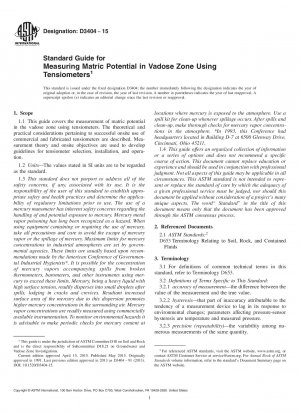ASTM D3404-15
Standard Guide for Measuring Matric Potential in Vadose Zone Using Tensiometers
- Standard No.
- ASTM D3404-15
- Release Date
- 2015
- Published By
- American Society for Testing and Materials (ASTM)
- Latest
- ASTM D3404-15
- Scope
5.1 Movement of water in the unsaturated zone is of considerable interest in studies of hazardous-waste sites (1, 2, 3, 4)3; recharge studies (5, 6); irrigation management (7, 8, 9); and civil-engineering projects (10, 11). Matric-potential data alone can be used to determine direction of flow (11) and, in some cases, quantity of water flux can be determined using multiple tensiometer installations. In theory, this technique can be applied to almost any unsaturated-flow situation whether it is recharge, discharge, lateral flow, or combinations of these situations.
5.2 If the moisture-characteristic curve is known for a soil, matric-potential data can be used to determine the approximate water content of the soil (10). The standard tensiometer is used to measure matric potential between the values of 0 and8201;-867 cm of water; this range includes most values of saturation for many soils (12).
5.3 Tensiometers directly and effectively measure soil-water tension, but they require care and attention to detail. In particular, installation needs to establish a continuous hydraulic connection between the porous material and soil, and minimal disturbance of the natural infiltration pattern are necessary for successful installation. Avoidance of errors caused by air invasion, nonequilibrium of the instrument, or pressure-sensor inaccuracy will produce reliable values of matric potential.
5.4 Special tensiometer designs have extended the normal capabilities of tensiometers, allowing measurement in cold or remote areas, measurement of matric potential as low as8201;-153 m of water (-15 bars), measurement at depths as deep as 6 m (recorded at land surface) for conventional tensiometers, depths up to 200 m and greater with advanced and portable versions (13, 14), and automatic measurement using as many as 22 tensiometers connected to a single pressure transducer, but these require a substantial investment of effort and money.
5.5 Pressure sensors commonly used in tensiometers include vacuum gauges, mercury manometers, and pressure transducers. Only tensiometers equipped with pressure transducers allow for the automated collection of large quantities of data. However, the user needs to be aw......
ASTM D3404-15 Referenced Document
- ASTM D653 Standard Terminology Relating to Soil, Rock, and Contained Fluids
ASTM D3404-15 history
- 2015 ASTM D3404-15 Standard Guide for Measuring Matric Potential in Vadose Zone Using Tensiometers
- 1991 ASTM D3404-91(2013) Standard Guide for Measuring Matric Potential in Vadose Zone Using Tensiometers
- 1991 ASTM D3404-91(2004) Standard Guide for Measuring Matric Potential in Vadose Zone Using Tensiometers
- 1991 ASTM D3404-91(1998) Standard Guide for Measuring Matric Potential in the Vadose Zone Using Tensiometers

Copyright ©2024 All Rights Reserved